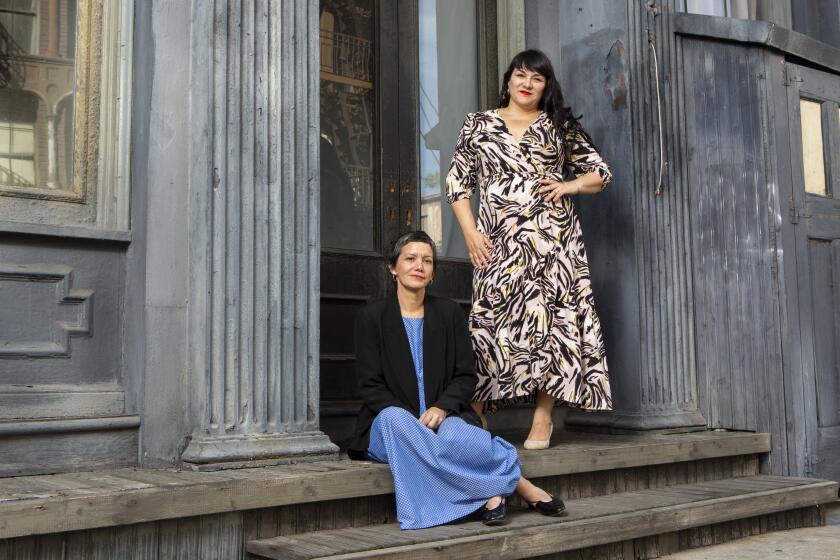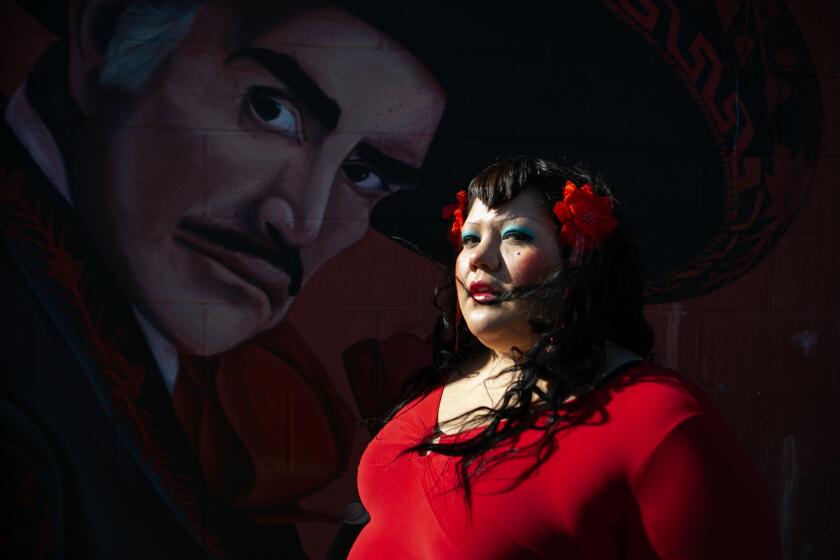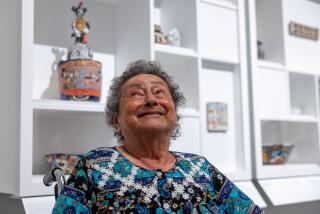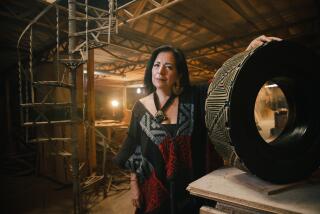Painter Shizu Saldamando puts a face to L.A.’s Latinx art and punk scenes

- Share via
To be in a gallery filled with portraits by Shizu Saldamando is to stand by her side at a rowdy concert or to observe the casual encounters among her circle of friends. There are laughs and kisses and surges of sweaty bodies as they rush a stage. There is the smoking of cigarettes; there are moments marinated in booze. There are the intimate choreographies of longtime friendships: embraces, exchanged whispers, passing glances.
For more than two decades, the Los Angeles painter has captured the people in her midst. In her 20s and 30s, they were the flamboyant poets and punks she hung out with in the city’s underground music scenes. Now, at 41, and the mother of a 3-year-old son, her portraits have calmed, frequently focusing on her circle of artist friends.
“I was doing a show once and [the organizers] told me they were interested in my youth subculture paintings,” Saldamando says. “I had to explain that I wasn’t trying to be about youth subculture. It was just my life. Now I’ve gravitated to more professional artists. It’s still personal, about who my friends are and who I admire.”
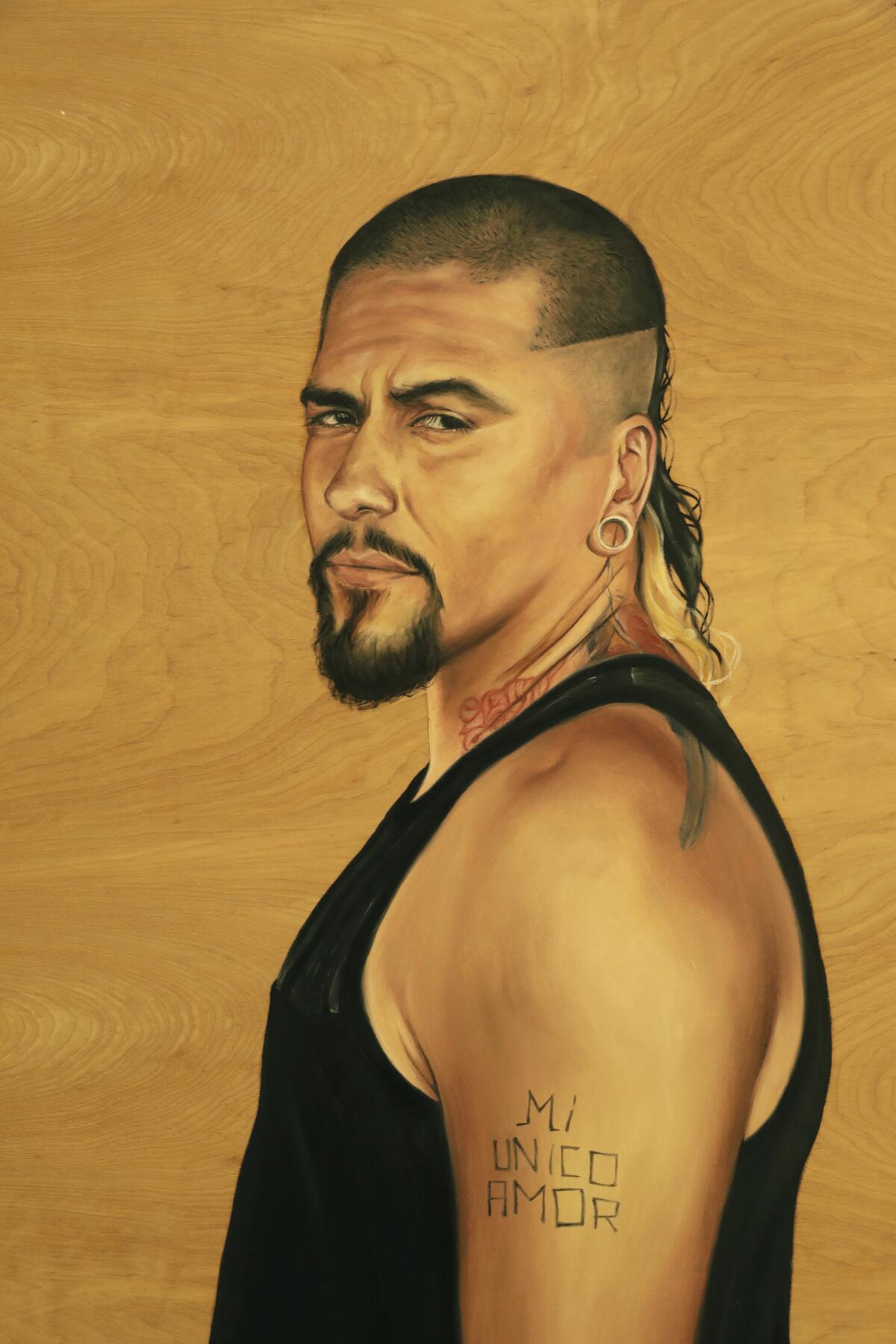
It’s a gusty Friday afternoon in L.A., and Saldamando is decked out in a pair of overalls, overseeing installation of her solo exhibition “L.A. Intersections” at Oxy Arts, the cultural space run by Occidental College in Highland Park, where Saldamando is an artist in residence.
Do we need more images and more paintings of the struggling immigrant? ... There is more to the Latinx experience than trauma.
— Shizu Saldamando, painter
From the walls, a bevy of recognizable L.A. artists gaze over her: performance and installation artist Rafa Esparza, painter Ramiro Gomez, poet Raquel Gutiérrez, artist and archivist Guadalupe Rosales, finely rendered in paint and ink and colored pencil on un-primed materials, such as pieces of wood panel that reveal the grain of the tree — a pattern that has the effect of serving as abstracted landscape.
For the artist, the paintings are as much about capturing her milieu as they are about representation — a way to insert images of her hybrid Latinx and Asian identities into a culture where these are often rendered as foreign, when they are rendered at all. (Saldamando is the daughter of a Chicano father and a Japanese American mother.)
“When I started doing portraits in art school, I was hyper-aware of exoticization issues, being an Asian woman,” she says. “I’m not trying to do some Larry Clark ‘look-at-these-kids’ thing.”
Instead, in choosing to depict the people around her, she aims to rewrite some of the narratives that exist.
“Do we need more images and more paintings of the struggling immigrant?” she asks rhetorically. “That’s a huge narrative. ... There is more to the Latinx experience than trauma.”
Saldamando updates that narrative, often featuring racially ambiguous figures in band shirts and black leather jackets, hair rendered in chemical shades of blue, green and pink. They are the everypunks of cities like Los Angeles, Phoenix, Houston and San Francisco. They could not be more American. And they could not be more full of life.
“There is this intimacy to her drawings and paintings which bring you into these vulnerable moments with her subjects,” says Oxy Arts director Meldia Yesayan. “But she creates this reverential distance as well. She can harmonize form, light and space in a way that really captures you. I really appreciate her influences: Pop, Minimalism, street art, old master portraiture. It’s really unique.”
For Frieze Projects inside this year’s Frieze Los Angeles, curators Rita Gonzalez and Pilar Tompkins Rivas asked artists to examine the representation of Latinos and others in movies and on TV.
Saldamando rose to prominence in the exhibition “Phantom Sightings: Art After the Chicano Movement,” which opened at the Los Angeles County Museum of Art in 2008. The show, organized by curators Rita Gonzalez, Chon Noriega and Howard Fox, examined a generation of Chicano artists whose work echoed conceptual art movements, along with the countercultural revolutions of the 1960s and ‘70s.
Saldamando’s contribution to that show included painted portraits on wood, the format for which she is best known. But it also included a series of innovative works inspired by paño art, the ballpoint-on-handkerchief drawings that are a staple of prison art. In their original form, these frequently carry the signifiers of Chicano and cholo cultures, including Aztec imagery and Old English lettering.
Her versions featured neat renderings of New Wave musicians such as Siouxsie Sioux of Siouxsie and the Banshees. It was as much a nod to obscure forms of art-making as it was to popular culture. What her work proposed, noted the catalog essay on her work for “Phantom Sightings,” is “a decidedly contemporary take on portraiture.”
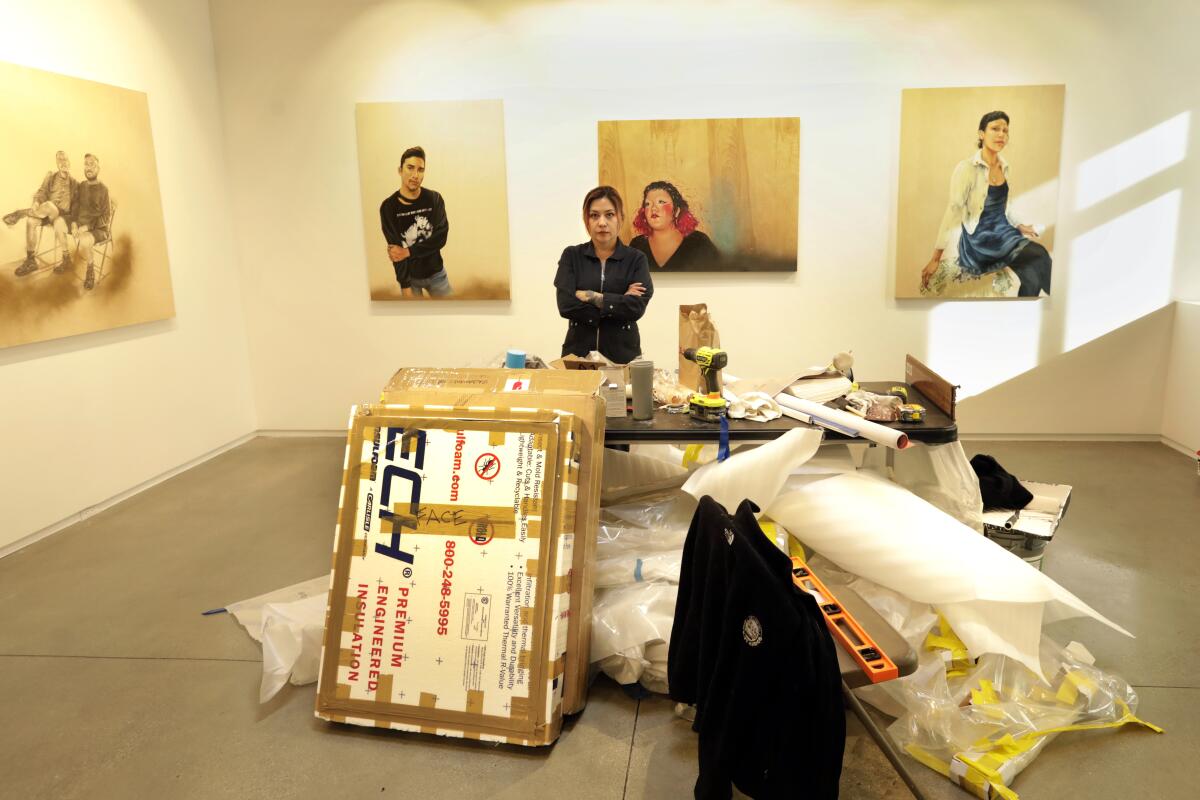
The diversity of influences, to some degree, speaks to Saldamando’s roots.
Born in San Francisco, she grew up in the Mission District before the neighborhood became a playground for the tech industry. “I’m like a unicorn,” she says. “I’m from the actual city.”
Her mother came from a Japanese American family that for a time lived in Boyle Heights but had their lives turned upside down when World War II came around and they were shipped off to internment camps.
“They were at Santa Anita Race Track and then Arkansas,” Saldmando says. Her mother was conceived at the Rohwer War Relocation Center and was born in Chicago. The family relocated back to Los Angeles when she was 13. “My mom’s family is still dealing with it. It was so traumatic.”
It’s a legacy the artist also pays tribute to with her work: Saldamando regularly leads craft sessions in which she teaches others how to make paper flower wreaths, the same kind used to bury the dead at internment camps, where fresh flowers were unavailable.
Her mother and father met in Los Angeles (he is originally from Nogales, Ariz.) but soon relocated to San Francisco, where they worked as a community organizer and pro bono lawyer for Catholic Charities, respectively. “He was working with Central Americans who were fleeing torture,” Saldamando says. “The Mission District was heavily Central American.”
The Los Angeles artist who outcools the skinny girls, Gabriela Ruiz delivers surreal DIY visions of herself in “Full of Tears” at the Vincent Price Art Museum.
Her mixed heritage and San Francisco location exposed Saldamando to an array of art-making traditions.
As a young girl, she was often taken to her mother‘s work, where Saldamando would occupy herself with a notebook and pencils. As she got older, she became a regular at neighborhood artistic outposts such as the Mission Cultural Center for Latino Arts and Galería de la Raza, an artist-run space established by Chicano artists in 1970.
Chicano art has always been an area of intense interest to her: “I’m interested in people. And the interest in Chicano art is because it has been very figurative. Seeing yourself — representation is important.”
But she has been just as interested in investigating its more marginal forms. “I would see a lot of prison art and I would read ‘Teen Angel,’” she says. “I was watching [the TV series] ‘Gangland’ — that had so much influence. There was cholo art I was influenced by. We’d try to copy the ballpoint pen drawings we would see.”
By high school, she was regularly making portraits of friends, often using colored pencils and ballpoint pens, often laced with stylized lettering, a service for which she would charge.
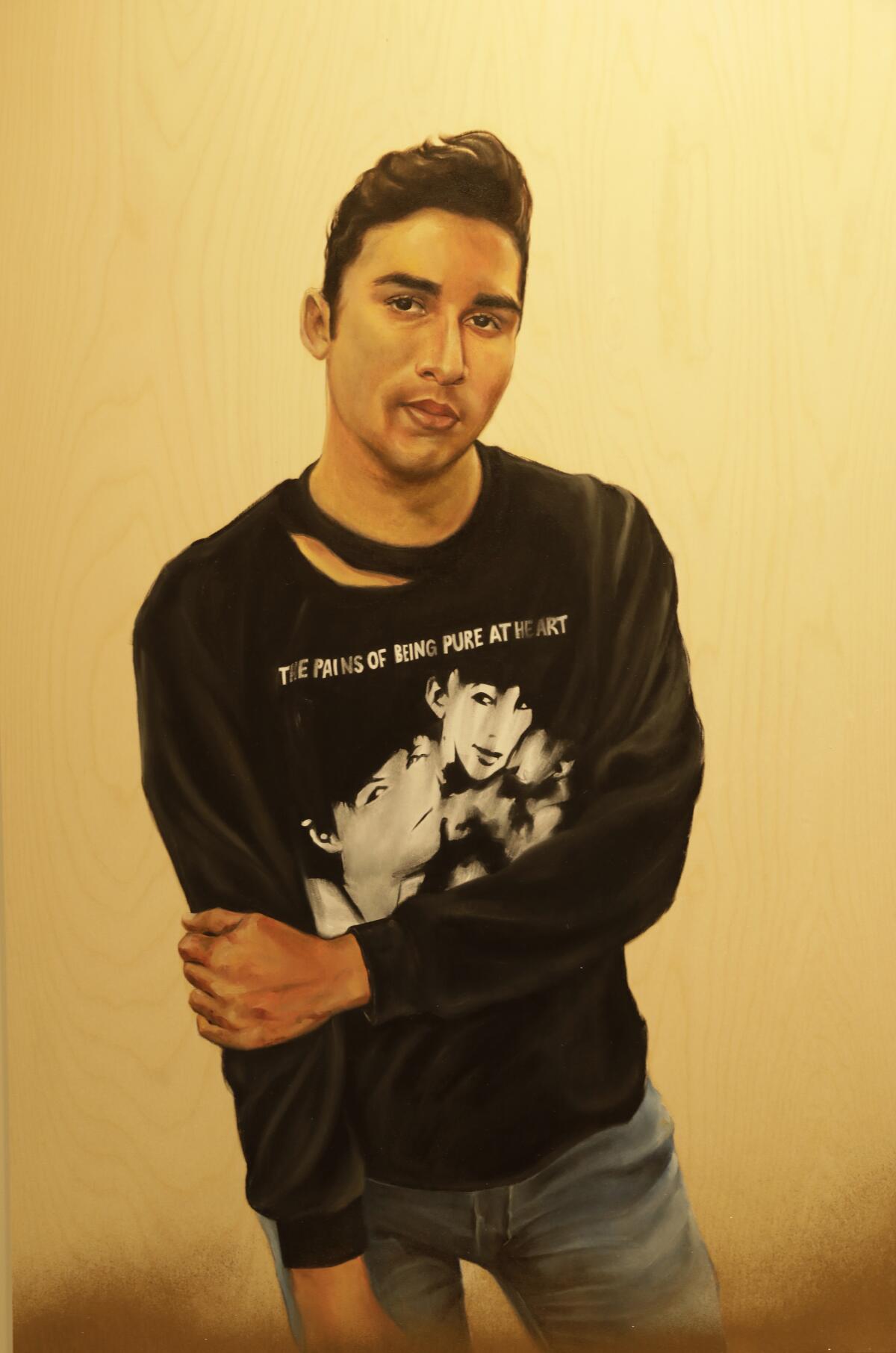
After high school, Saldamando moved to Los Angeles to complete her undergraduate studies at UCLA. She followed that with a master of fine art at CalArts, which she completed in 2005. But just as influential to her painting as her education was her immersion in L.A.’s music scene.
“The club scene in L.A. in the mid-’90s was so crazy,” she says. “Club Bang, Perversion, Satellite — which was Dark Wave. Club London at Vertigo. They were predominantly Latinx. “
Saldamando loved the music but also what the clubs represented: “Music is people coming together and connecting and getting crazy and releasing trauma. It’s a communal thing — to get drunk and release tension.”
Armed with a camera, Saldamando would often photograph friends out on the town, in the middle of riotous concerts and crashing out after parties. These would frequently become the basis of paintings. She was fascinated by gesture and body language and the ways that people present themselves.
“I gravitate to people who construct themselves as high art,” she says. “They put themselves together in a style that they have honed out of economic necessity or cultural things. It’s people who are like art already.”
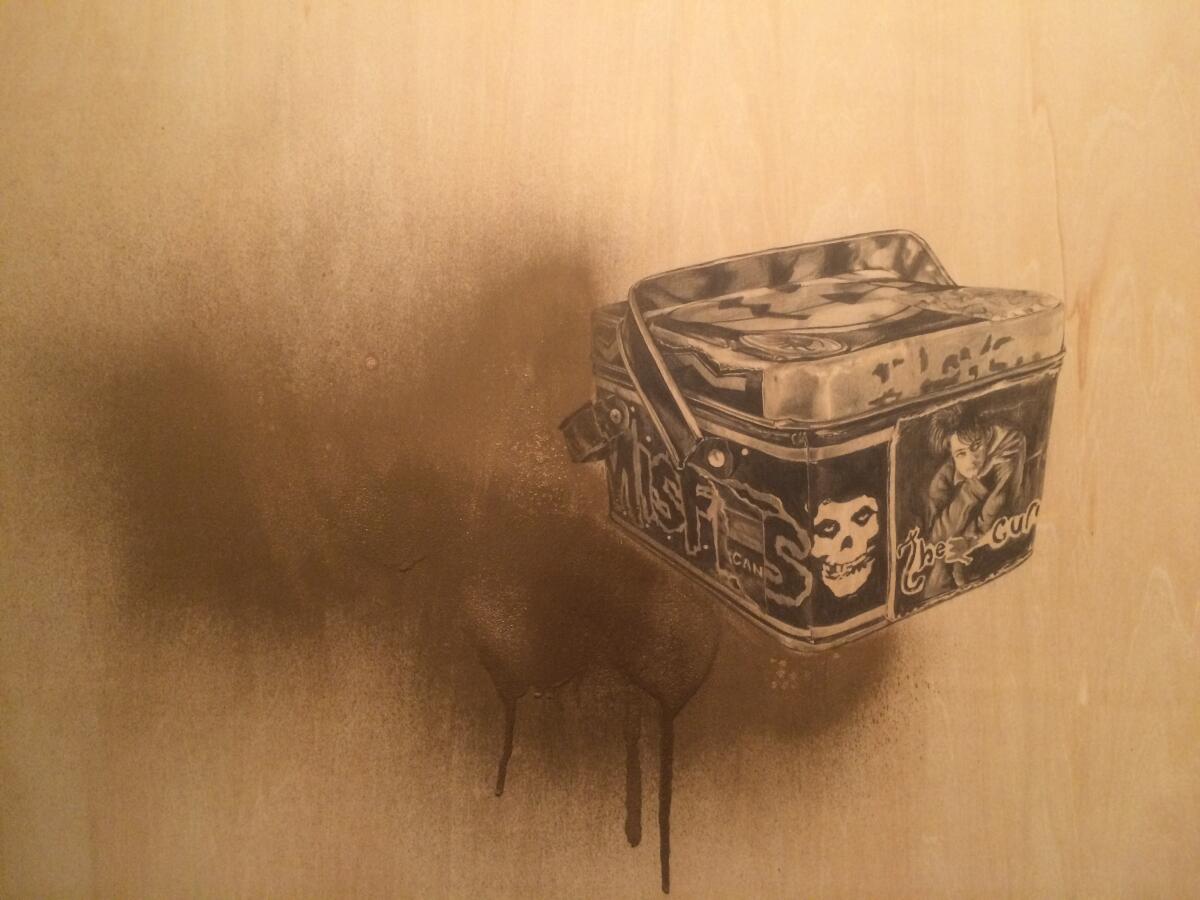
Over the years, myriad elements and materials have appeared in her work. Fragments of reflective stickers and bright Japanese washi yuzen papers appear as collage. She has used glitter and cardboard to add texture to works painted on wood or on paper. Bedsheets and tablecloths become canvases. In addition to people, she has chronicled ephemera, like the paintings of hand-decorated lunchboxes (all very punk) that appeared in “Transpacific Borderlands: The Art of Japanese Diaspora in Lima, Los Angeles, Mexico City and São Paulo,” which took place at L.A.’s Japanese American National Museum in 2017.
In addition to painting, Saldamando has a flourishing tattoo practice, specializing in portrait tattoos — an art form she got into after a friend was looking for someone to do a portrait tattoo of her mother, who had died from cancer. “We were looking online and I was like, ‘I can do this way better,’” she recalls.
She apprenticed for several years at a shop in East L.A. to develop her skills. “I practiced on my poor friends,” she says with a chuckle.
But it is the painted portraiture that serves as the spine of her work. Mainly, individuals on blank backgrounds, divorced from their context, their bodies, not the setting, telling the story.
“I’m just not interested in backgrounds,” she says. “I’ve always just been genetically interested in what people have going on here,” she adds, gesturing at her own face.
“They don’t have to be exceptional persons of color. They don’t have to be organizing. They don’t have to be dead. They don’t have to be a martyr. They can just be relatable.”
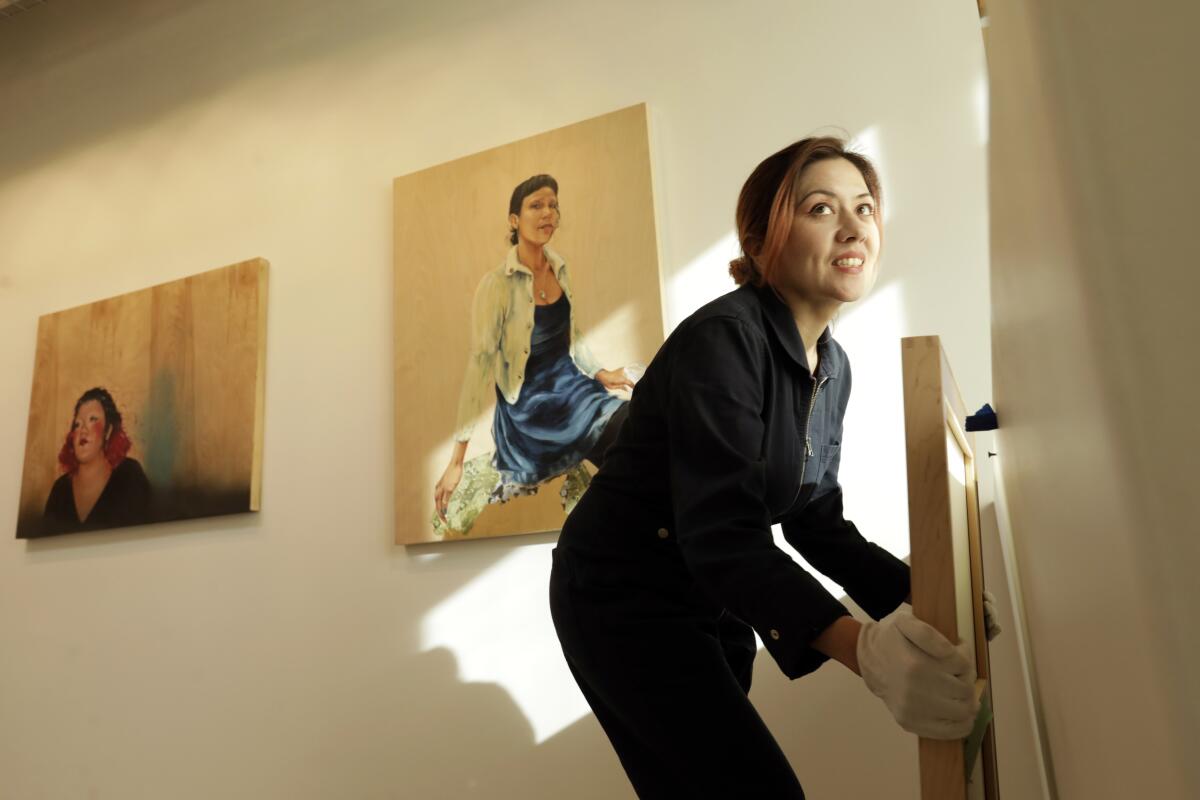
Saldamando is prepping for a two-woman show with painter Esther Hernandez that will take place at the National Museum of Mexican Art in Chicago in the fall. “I’m really excited,” she says. “I remember seeing her work as a teenager — that portrait of her girlfriend with a mohawk and the Virgin Mary on her back, it’s really great.”
But first, she has plenty to do in L.A. As Occidental’s 2019-20 Wanlass Artist in Residence, a 7-year-old residency program that invites a different contemporary artist to campus every year, she must teach, make work and produce a catalog. She’s also putting together a raft of events to accompany her exhibition, including readings and presentations by many of the artists she painted for her show. (Carolina Caycedo, an L.A.-based artist known for her environmental work, will be next year’s resident artist.)
“This is the first time in my life that I feel part of this larger Latinx artist community,” she says. “There is this group of artists embracing queerness and gender nonconformity and staunchly being anti-machismo. ... This is a group I have something in common with.”
And they are the people she likes to paint.
Shizu Saldamando: L.A. Intersections
When: Through April 17
Where: Oxy Arts, 4757 York Blvd., Highland Park
Info: oxy.edu
More to Read
The biggest entertainment stories
Get our big stories about Hollywood, film, television, music, arts, culture and more right in your inbox as soon as they publish.
You may occasionally receive promotional content from the Los Angeles Times.
